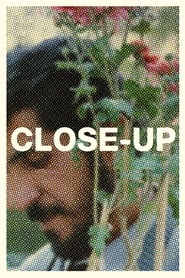Not sure if it has an equivalent in Farsi, but I love the visual pun when the driver literally kicks the can down the road.
Does Close-Up reveal the truth? I’d prefer to say it reveals the beauty of distortion. […] Perhaps so many of Kiarostami’s films […] don’t care about the line between documentary and fiction because, in the grand sense, he doesn’t see one.
— Josh Larsen (Larsen on Film)
[After the introduction], a credit sequence that challenges, blurs, and complicates any perception the spectator may have of realist cinema: Close-Up may be based on a true story, but its actors are all playing themselves.
— Ed Gonzalez (Slant)
As happens in many Kiarostami films that involve car rides, the taxi driver repeatedly stops to ask directions, evoking a sense of disorientation that mirrors our own. Then, when the destination is reached, something decidedly odd happens—not only in what the film shows but also in the way it shows it. When Farazmand and then the soldiers go into the house for the arrest of the impostor, the camera doesn’t follow them. Rather, it stays with the driver, who turns his taxi around, gets out, looks up at a jet’s twin exhaust trails bisecting the sky, and picks a little bouquet of flowers out of a rubbish heap. As he does, he dislodges an aerosol can that rolls slowly down the street, observed by Kiarostami’s camera for what seems like an extraordinary length of time. […] In withholding the important event we expect to see and focusing instead on an unimportant character involved in idle, inconsequential actions, this scene—often cited as one of the most striking in Kiarostami’s work—recalls the director’s stated intent to craft “half-made” films that must be completed by the audience’s imagination.
[…]
Kiarostami subsequently bamboozled all of the participants into performing in his film. But the ultimate source of bamboozlement here, clearly, is cinema itself. Its power to bewitch is evident every time Kiarostami turns on his camera. The Ahankhahs, the reporter, the soldiers, and the rest—all seem swept up by the medium’s peculiar magic. That power, no doubt, was especially pronounced at that particular moment in the Islamic republic, when many of the great dreams inspired by the revolution had dwindled, and when other public art forms had been suppressed while cinema was revived and privileged, with some directors emerging as cultural luminaries.
[…]
It should be noted that Kiarostami scripted most of Sabzian’s speeches at trial, though he based them on things Sabzian had actually said. The circumstances here, then, could not be more artificial. […] In reality, Kiarostami coaxed the judge into his verdict. The Ahankhahs were outraged; they wanted Sabzian to be convicted. Even Sabzian went to the judge later and complained, saying he felt sure Kiarostami had somehow tricked him! As for the moving departure from prison, it was staged, and Kiarostami shot from a distance purely for dramatic (or docudramatic) effect. And those “sound problems”? Most were created during postproduction to serve the final scene’s emotional punch.
— Godfrey Cheshire (Criterion)
In focusing on Sabzian, Kiarostami saw something that hadn’t yet been identified in cinema: the exact point where, if for only a moment, the movies and real life dissolve into each other, before detaching again, as mirror images.
— A. S. Hamrah (Criterion)
Synopsis: This fiction-documentary hybrid uses a sensational real-life event—the arrest of a young man on charges that he fraudulently impersonated the well-known filmmaker Mohsen Makhmalbaf—as the basis for a stunning, multilayered investigation into movies, identity, artistic creation, and existence, in which the real people from the case play themselves.

